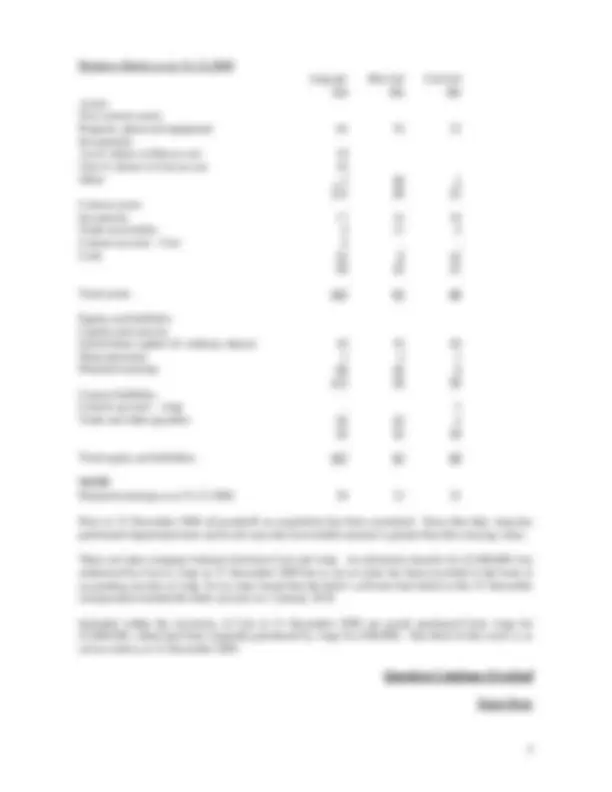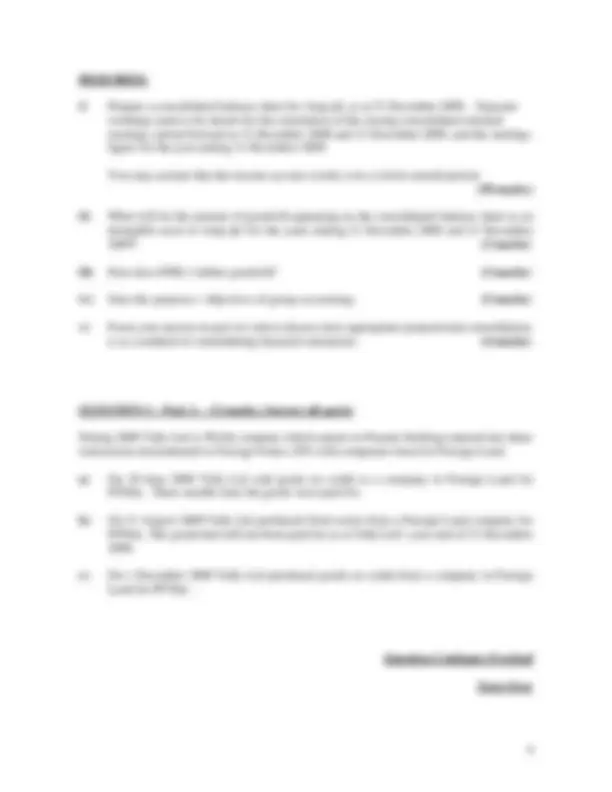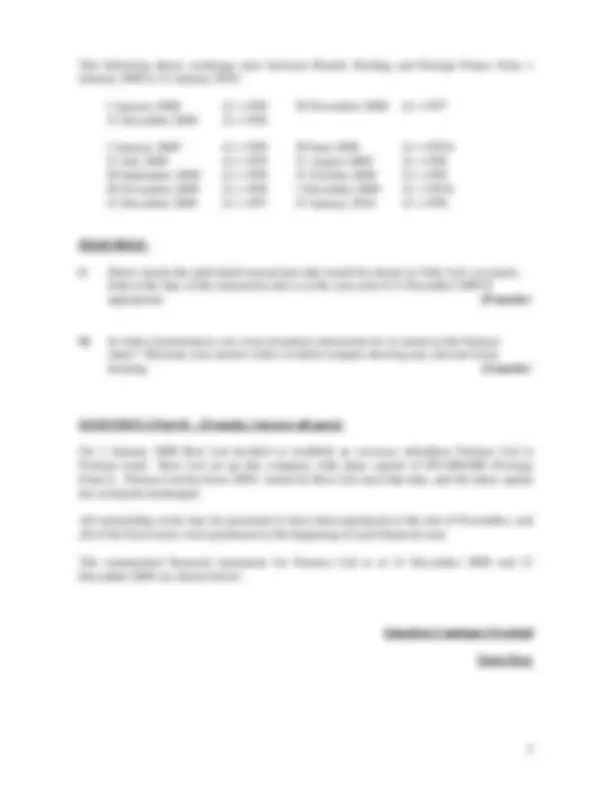Download Share Capital - Financial Accounting - Past Exam and more Exams Accounting in PDF only on Docsity!
ARHOLIADAU EXAMINATIONS
Mai / Mehefin 2010 May / June 2010
AC30920 FINANCIAL ACCOUNTING III
Time allowed: TWO Hours
ANSWER TWO QUESTIONS:
ANSWER QUESTION ONE (COMPULSORY)
AND ANSWER EITHER QUESTION TWO OR QUESTION THREE (BUT NOT
BOTH)
Each question has multiple parts. Answer all parts of each question you attempt.
In calculations of financial figures in your answers and workings, round numbers to the
nearest one decimal place.
State clearly any assumptions you make.
Total 100 marks available. Question one carries 65 marks, and each of questions two and
three carry 35 marks.
This paper contributes 80% of the overall module mark.
Casio FX83ES or FX85ES calculators only may be used.
Turn over
QUESTION 1 – Part A - 20 marks (Answer all parts)
On 31 December 2009 Lion Ltd, which then had no subsidiaries, made an offer of 4 £1 ordinary shares in Lion Ltd for every 10 £1 ordinary shares in Ferret Ltd. All the shareholders of Ferret Ltd immediately accepted this offer. The market value of each £1 share in Lion before and after the takeover was £5. The balance sheets of Lion Ltd and Ferret Ltd immediately before the takeover showed the following:
Lion Ltd Ferret Ltd £m £m
Net assets 400 60
Share capital £1 shares 350 40 Profit and loss reserves 50 20 400 60
Lion Ltd and Ferret Ltd use different methods for allocating overheads to stock. Application of a common method would result in Ferret Ltd’s stock valuation being reduced by £2m. A fair valuation exercise as at 31 December 2009 showed that Ferret Ltd’s fixed assets were understated by £15m.
REQUIRED:
i) What were the two approaches allowed to consolidate a company’s financial statements under FRS 6? (2 marks)
ii) Using the information above, prepare a draft consolidated balance sheet immediately after the acquisition on each of the following bases:
a) Formerly allowed by FRS 6, but is now NOT allowed by IFRS 3 (6 marks)
b) As per IFRS 3 (6 marks)
iii) Compare and contrast the two methods that were allowed under FRS 6. (6 marks)
QUESTION 1 – Part B – 45 marks (Answer all parts)
Below are the summarized balance sheets of Amp plc, Bite Ltd and Cart Ltd as at 31 December 2009.
Amp purchased the shares in Bite on 30 September 2009, on which date the retained earnings were £15,000,000. Amp has representation on the board and is adjudged to have significant influence. The holding in Cart was purchased over 40 years ago on which date the retained earnings were £2,000,000. When purchasing the shares in both Bite and Cart, Amp considered the net assets to be at fair value and there has been no additional capital issued since date of purchase.
Question Continues Overleaf
Turn Over
REQUIRED:
i) Prepare a consolidated balance sheet for Amp plc as at 31 December 2009. Separate
workings need to be shown for the calculation of the closing consolidated retained
earnings carried forward at 31 December 2008 and 31 December 2009, and the earnings
figure for the year ending 31 December 2009.
You may assume that the income accrues evenly over a twelve-month period.
(30 marks)
ii) What will be the amount of goodwill appearing on the consolidated balance sheet as an
intangible asset of Amp plc for the years ending 31 December 2008 and 31 December
2009? (3 marks)
iii) How does IFRS 3 define goodwill? (3 marks)
iv) State the purposes / objectives of group accounting. (5 marks)
v) From your answer in part (iv) above discuss how appropriate proportional consolidation
is as a method of consolidating financial statements. (4 marks)
QUESTION 2 – Part A – 12 marks (Answer all parts)
During 2009 Tally Ltd (a Welsh company which reports in Pounds Sterling) entered into three
transactions denominated in Foreign Francs (FF) with companies based in Foreign Land:
a) On 30 June 2009 Tally Ltd sold goods on credit to a company in Foreign Land for
FF20m. Three months later the goods were paid for.
b) On 31 August 2009 Tally Ltd purchased fixed assets from a Foreign Land company for
FF56m. The goods had still not been paid for as at Tally Ltd’s year end of 31 December
c) On 1 December 2009 Tally Ltd purchased goods on credit from a company in Foreign
Land for FF70m..
Question Continues Overleaf
Turn Over
The following shows exchange rates between Pounds Sterling and Foreign Francs from 1
January 2008 to 31 January 2010:
1 January 2008 £1 = FF8 30 November 2008 £1 = FF
31 December 2008 £1 = FF
1 January 2009 £1 = FF6 30 June 2009 £1 = FF
31 July 2009 £1 = FF9 31 August 2009 £1 = FF
30 September 2009 £1 = FF8 31 October 2009 £1 = FF
30 November 2009 £1 = FF8 1 December 2009 £1 = FF
31 December 2009 £1 = FF7 31 January 2010 £1 = FF
REQUIRED:
i) Show clearly the individual transactions that would be shown in Tally Ltd’s accounts,
both at the date of the transaction and as at the year end of 31 December 2009 if
appropriate. (8 marks)
ii) In what circumstances can a non-monetary transaction be re-stated on the balance
sheet? Illustrate your answer with a worked example showing any relevant book-
keeping. (4 marks)
QUESTION 2 Part B – 23 marks (Answer all parts)
On 1 January 2008 Bow Ltd decided to establish an overseas subsidiary Furnace Ltd in
Foreign Land. Bow Ltd set up this company with share capital of FF1,000,000 (Foreign
Francs). Furnace Ltd has been 100% owned by Bow Ltd since that date, and the share capital
has remained unchanged.
All outstanding stock may be presumed to have been purchased at the end of November, and
all of the fixed assets were purchased at the beginning of each financial year.
The summarized financial statements for Furnace Ltd as at 31 December 2008 and 31
December 2009 are shown below:
Question Continues Overleaf
Turn Over
QUESTION 3 – 35 marks (Answer all parts)
Gwynfa Ltd, which was established on 1 April 2006, has financial accounting profits before
taxation for the financial years ending 31 March 2007, 2008, 2009 and 2010 of £10m, £15m,
£18m and £5m respectively.
The purchases of depreciable assets were made on the first day of each year, and company
policy is to write off these assets on a straight line basis over ten years. As the company is
prudent, Gwynfa Ltd presumes no residual value for these assets. The depreciation charge for
each of these four years was £2m in 2006 and 2007, £2.8m in 2008 and £5m in 2009. These
assets attract writing down allowances for tax purposes at 25% on a reducing balance basis.
In each of the four years of trading a £1m charge for post-retirement health benefits was
charged to the income statement. The only actual payment for post-retirement health care was
a sum of £0.5m in March 2009.
During the first year of trading no provisions were made for bad debts, but at the end of the
second year it was decided to make a general bad debt provision of £3m. This provision was
increased to £4m for the year ending March 2009. In January 2010 a customer was unable to
pay a debt of £0.8m, this was written off straight away. The bad debt provision was reduced
by the same amount.
Also included in the accounting profits were interest payments. The company took out a three
year loan of £10m on the 1 October 2006. Interest is payable at 10% per annum, six monthly
in arrears on 1 April and 1 October.
REQUIRED :
i) Calculate the profits chargeable to corporation tax for the first four years of trading.
(12 marks)
ii) Assuming a corporation tax rate of 25%, calculate the deferred tax charge on a full
provision basis for each of the three years using the liability method. Show clearly the
yearly deferred tax charge to the income statement and the closing balance on the
balance sheet. (10 marks)
iii) From the 1 April 2008 the tax rate changes to 15%, calculate the deferred tax charge for
the years ending 31 March 2009 and 31 March 2010 using:
a) Liability method (3 marks)
b) Deferral method (3 marks)
iv) Discuss the three methods of calculating deferred tax. (7 marks)
END OF PAPER














